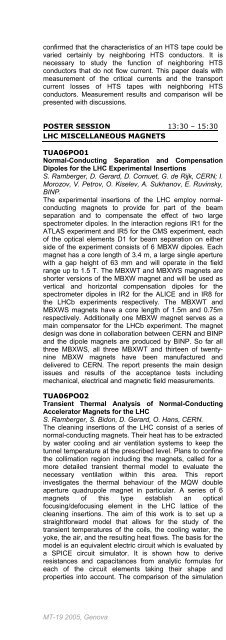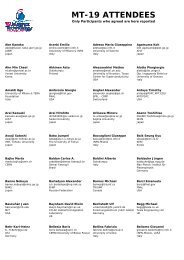Click here to download the abstract booklet in pdf format - MT19 - Infn
Click here to download the abstract booklet in pdf format - MT19 - Infn
Click here to download the abstract booklet in pdf format - MT19 - Infn
Create successful ePaper yourself
Turn your PDF publications into a flip-book with our unique Google optimized e-Paper software.
confirmed that <strong>the</strong> characteristics of an HTS tape could be<br />
varied certa<strong>in</strong>ly by neighbor<strong>in</strong>g HTS conduc<strong>to</strong>rs. It is<br />
necessary <strong>to</strong> study <strong>the</strong> function of neighbor<strong>in</strong>g HTS<br />
conduc<strong>to</strong>rs that do not flow current. This paper deals with<br />
measurement of <strong>the</strong> critical currents and <strong>the</strong> transport<br />
current losses of HTS tapes with neighbor<strong>in</strong>g HTS<br />
conduc<strong>to</strong>rs. Measurement results and comparison will be<br />
presented with discussions.<br />
POSTER SESSION 13:30 – 15:30<br />
LHC MISCELLANEOUS MAGNETS<br />
TUA06PO01<br />
Normal-Conduct<strong>in</strong>g Separation and Compensation<br />
Dipoles for <strong>the</strong> LHC Experimental Insertions<br />
S. Ramberger, D. Gerard, D. Cornuet, G. de Rijk, CERN; I.<br />
Morozov, V. Petrov, O. Kiselev, A. Sukhanov, E. Ruv<strong>in</strong>sky,<br />
BINP.<br />
The experimental <strong>in</strong>sertions of <strong>the</strong> LHC employ normalconduct<strong>in</strong>g<br />
magnets <strong>to</strong> provide for part of <strong>the</strong> beam<br />
separation and <strong>to</strong> compensate <strong>the</strong> effect of two large<br />
spectrometer dipoles. In <strong>the</strong> <strong>in</strong>teraction regions IR1 for <strong>the</strong><br />
ATLAS experiment and IR5 for <strong>the</strong> CMS experiment, each<br />
of <strong>the</strong> optical elements D1 for beam separation on ei<strong>the</strong>r<br />
side of <strong>the</strong> experiment consists of 6 MBXW dipoles. Each<br />
magnet has a core length of 3.4 m, a large s<strong>in</strong>gle aperture<br />
with a gap height of 63 mm and will operate <strong>in</strong> <strong>the</strong> field<br />
range up <strong>to</strong> 1.5 T. The MBXWT and MBXWS magnets are<br />
shorter versions of <strong>the</strong> MBXW magnet and will be used as<br />
vertical and horizontal compensation dipoles for <strong>the</strong><br />
spectrometer dipoles <strong>in</strong> IR2 for <strong>the</strong> ALICE and <strong>in</strong> IR8 for<br />
<strong>the</strong> LHCb experiments respectively. The MBXWT and<br />
MBXWS magnets have a core length of 1.5m and 0.75m<br />
respectively. Additionally one MBXW magnet serves as a<br />
ma<strong>in</strong> compensa<strong>to</strong>r for <strong>the</strong> LHCb experiment. The magnet<br />
design was done <strong>in</strong> collaboration between CERN and BINP<br />
and <strong>the</strong> dipole magnets are produced by BINP. So far all<br />
three MBXWS, all three MBXWT and thirteen of twentyn<strong>in</strong>e<br />
MBXW magnets have been manufactured and<br />
delivered <strong>to</strong> CERN. The report presents <strong>the</strong> ma<strong>in</strong> design<br />
issues and results of <strong>the</strong> acceptance tests <strong>in</strong>clud<strong>in</strong>g<br />
mechanical, electrical and magnetic field measurements.<br />
TUA06PO02<br />
Transient Thermal Analysis of Normal-Conduct<strong>in</strong>g<br />
Accelera<strong>to</strong>r Magnets for <strong>the</strong> LHC<br />
S. Ramberger, S. Bidon, D. Gerard, O. Hans, CERN.<br />
The clean<strong>in</strong>g <strong>in</strong>sertions of <strong>the</strong> LHC consist of a series of<br />
normal-conduct<strong>in</strong>g magnets. Their heat has <strong>to</strong> be extracted<br />
by water cool<strong>in</strong>g and air ventilation systems <strong>to</strong> keep <strong>the</strong><br />
tunnel temperature at <strong>the</strong> prescribed level. Plans <strong>to</strong> conf<strong>in</strong>e<br />
<strong>the</strong> collimation region <strong>in</strong>clud<strong>in</strong>g <strong>the</strong> magnets, called for a<br />
more detailed transient <strong>the</strong>rmal model <strong>to</strong> evaluate <strong>the</strong><br />
necessary ventilation with<strong>in</strong> this area. This report<br />
<strong>in</strong>vestigates <strong>the</strong> <strong>the</strong>rmal behaviour of <strong>the</strong> MQW double<br />
aperture quadrupole magnet <strong>in</strong> particular. A series of 6<br />
magnets of this type establish an optical<br />
focus<strong>in</strong>g/defocus<strong>in</strong>g element <strong>in</strong> <strong>the</strong> LHC lattice of <strong>the</strong><br />
clean<strong>in</strong>g <strong>in</strong>sertions. The aim of this work is <strong>to</strong> set up a<br />
straightforward model that allows for <strong>the</strong> study of <strong>the</strong><br />
transient temperatures of <strong>the</strong> coils, <strong>the</strong> cool<strong>in</strong>g water, <strong>the</strong><br />
yoke, <strong>the</strong> air, and <strong>the</strong> result<strong>in</strong>g heat flows. The basis for <strong>the</strong><br />
model is an equivalent electric circuit which is evaluated by<br />
a SPICE circuit simula<strong>to</strong>r. It is shown how <strong>to</strong> derive<br />
resistances and capacitances from analytic formulas for<br />
each of <strong>the</strong> circuit elements tak<strong>in</strong>g <strong>the</strong>ir shape and<br />
properties <strong>in</strong><strong>to</strong> account. The comparison of <strong>the</strong> simulation<br />
results with temperature measurements on <strong>the</strong> coils and<br />
<strong>the</strong> yoke of <strong>the</strong> magnet confirm <strong>the</strong> lumped circuit model. It<br />
is also shown that <strong>the</strong> model reflects particular behaviour<br />
follow<strong>in</strong>g transient current changes. It is t<strong>here</strong>fore capable<br />
of predict<strong>in</strong>g complex transient temperature profiles<br />
result<strong>in</strong>g from its environment.<br />
TUA06PO03<br />
Field Quality Change <strong>in</strong> Accelera<strong>to</strong>r Magnets Due <strong>to</strong><br />
Re-Magnetization of Superconduc<strong>to</strong>r<br />
K. Sugita, The Graduate University for Advanced Studies;<br />
T. Ogitsu, N. Ohuchi, T. Nakamo<strong>to</strong>, K. Tsuchiya, C.<br />
Sh<strong>in</strong><strong>to</strong>mi, A. Yamamo<strong>to</strong>, KEK.<br />
A simulation program was developed <strong>to</strong> compute change of<br />
magnetic field quality orig<strong>in</strong>ated by <strong>in</strong>ter-strand current<br />
redistribution <strong>in</strong> Ru<strong>the</strong>rford cables. The program was based<br />
on a hypo<strong>the</strong>sis that <strong>the</strong> magnetic field quality is drifted by<br />
chang<strong>in</strong>g of superconduc<strong>to</strong>r filament magnetizations due <strong>to</strong><br />
local field changes follow<strong>in</strong>g imbalance current<br />
redistributions, especially dur<strong>in</strong>g periods of beam <strong>in</strong>jection.<br />
The imbalanced currents <strong>in</strong> cables were described by<br />
random zigzag currents with<strong>in</strong> limited current variation. A<br />
s<strong>in</strong>usoidal magnetic field modulation, so called a 'periodic<br />
pattern', and <strong>the</strong> local field on <strong>the</strong> strand were computed.<br />
The variations of <strong>the</strong> filament magnetizations due <strong>to</strong> <strong>the</strong><br />
local field changes, which cause <strong>the</strong> change of field quality<br />
<strong>in</strong> <strong>the</strong> magnet bore, were computed us<strong>in</strong>g a new model<br />
consist<strong>in</strong>g of multiple layers of persistent current hav<strong>in</strong>g<br />
cos<strong>in</strong>e <strong>the</strong>ta distribution. The computed results will be<br />
reported <strong>in</strong> comparisons with <strong>the</strong> measured results from 18<br />
superconduct<strong>in</strong>g quadrupole magnets (MQXAs) for <strong>the</strong><br />
LHC <strong>in</strong>sertion regions.<br />
TUA06PO04<br />
Focus<strong>in</strong>g strength measurements of <strong>the</strong> ma<strong>in</strong><br />
quadrupoles<br />
N. Smirnov, L. Bottura, M. Buzio, M. Calvi, G. Deferne, O.<br />
Dunkel, J. Garcia Perez, S. Sanfilippo, N. Sammut, CERN;<br />
J. DiMarco, FNAL.<br />
The 474 tw<strong>in</strong> aperture superconduct<strong>in</strong>g quadrupole<br />
magnets needed for <strong>the</strong> Large Hadron Collider (LHC) are<br />
assembled <strong>in</strong> up <strong>to</strong> 12 m long cryostats. Because of <strong>the</strong><br />
‘warm-bore’ <strong>in</strong>sert, t<strong>here</strong> is only 40 mm of roomtemperature<br />
measurement aperture available dur<strong>in</strong>g<br />
cryogenic tests, mak<strong>in</strong>g <strong>the</strong> <strong>in</strong>tegrated gradient of <strong>the</strong><br />
quadrupoles challeng<strong>in</strong>g <strong>to</strong> measure both efficiently and<br />
with <strong>the</strong> required 0.1% absolute accuracy. This contribution<br />
describes <strong>the</strong> various systems used <strong>to</strong> perform magnetic<br />
field test<strong>in</strong>g: Au<strong>to</strong>mated Scanner system, S<strong>in</strong>gle Stretched<br />
Wire system and Tw<strong>in</strong> Coils system, concentrat<strong>in</strong>g mostly<br />
on <strong>the</strong> absolute accuracies of <strong>the</strong>ir <strong>in</strong>tegrated gradient<br />
(Gdl) measurements. Most of <strong>the</strong> possible <strong>in</strong><strong>here</strong>nt effects<br />
that can <strong>in</strong>troduce systematic errors are discussed, along<br />
with <strong>the</strong>ir preventive methods. In understand<strong>in</strong>g <strong>the</strong><br />
systematic errors, a few samples of each of <strong>the</strong> several<br />
types of quadrupoles have been thoroughly measured with<br />
<strong>the</strong> different systems. The results of <strong>the</strong>se <strong>in</strong>tersystem<br />
cross-calibrations are presented. Also discussed are <strong>the</strong><br />
qualification results for <strong>the</strong> measurement systems used <strong>in</strong><br />
<strong>in</strong>dustry. This qualification is based on comparison of<br />
results for several quadrupole assemblies tested both <strong>in</strong><br />
cold conditions at CERN and at room temperature at <strong>the</strong><br />
manufacturer site.<br />
TUA06PO05<br />
Electrical and Magnetic Performance of <strong>the</strong> LHC Short<br />
Straight Sections<br />
S. Sanfilippo, M. Buzio, M. Coccoli, N. Smirnov, N.<br />
Sammut, A. Staf<strong>in</strong>iak, L. Bottura, P. Pugnat, A. Siemko, P.<br />
MT-19 2005, Genova 66



